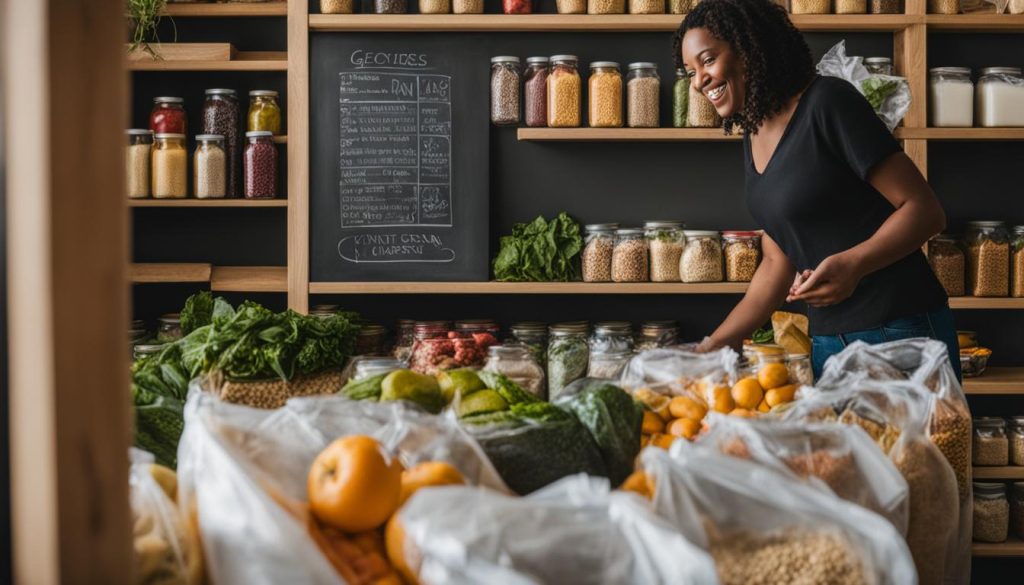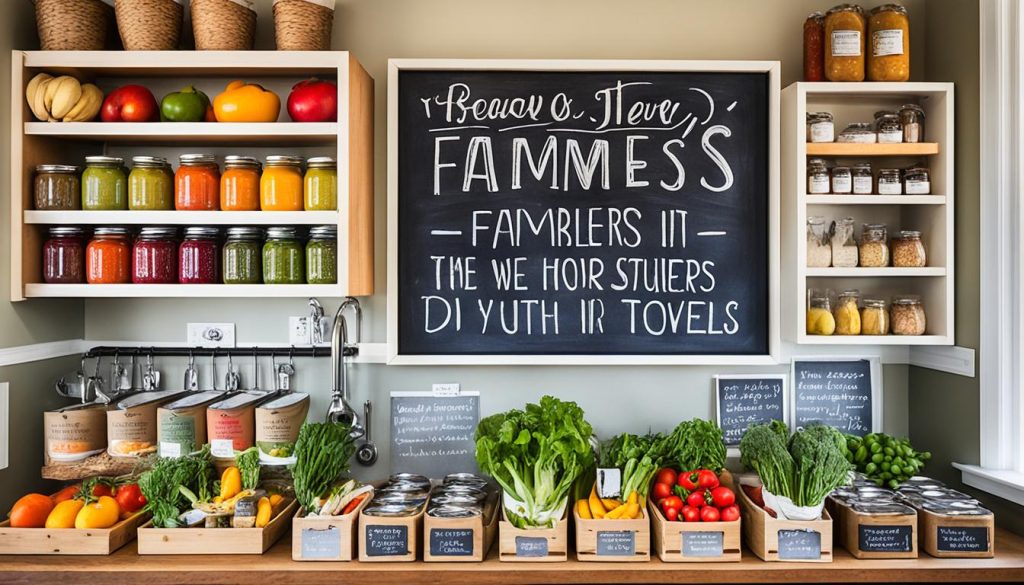Did you know that every day, one-third of the food supply goes to waste? This shocking statistic highlights the urgent need to create a sustainable pantry and embrace eco-friendly practices. By implementing waste reduction strategies, embracing green living, and managing your pantry effectively, you can make a significant impact on the environment and contribute to a greener, healthier home.
Key Takeaways:
- Reducing food waste is a crucial step in creating a sustainable pantry.
- By planning meals, freezing leftovers, and composting kitchen scraps, you can minimize food waste.
- Reducing plastic consumption is another important aspect of a sustainable pantry.
- Buying foods with minimal packaging and using reusable storage containers can help reduce plastic waste.
- Supporting local farmers and buying seasonal produce can lower the carbon footprint of your pantry.
Reduce Your Food Waste
One-third of the food supply goes to waste every day, making reducing food waste a crucial step in creating a sustainable pantry. Planning meals ahead of time and writing a grocery list can help you shop intentionally and avoid buying more than what you need. Freezing leftovers and kitchen scraps can also prevent food waste. Sign up for a curbside composting service to keep food scraps out of landfills and turn them into nutrient-rich soil. Reusing scraps to make homemade vegetable stock is another way to minimize food waste and create a useful pantry item.
Meal planning is a powerful tool to reduce food waste and ensure that you only purchase what you need. By planning your meals for the week and creating a shopping list, you can avoid impulse purchases and focus on buying essential ingredients. This approach not only reduces waste but also saves you time and money.
Another effective way to prevent food waste is by utilizing your freezer. Instead of letting leftovers go to waste, freeze them in individual portions for quick and easy meals in the future. You can also freeze fruits and vegetables that are nearing their expiration date to ensure they don’t go to waste. Just make sure to label and date each item to keep track of what’s in your freezer.
Composting is a sustainable solution for dealing with food scraps. Instead of throwing them in the trash, set up a small composting bin in your backyard or sign up for a curbside composting service. This way, you can turn your food waste into nutrient-rich compost that can be used to fertilize your garden or potted plants. Composting not only reduces waste but also contributes to the health of your soil and plants.
Another creative way to minimize food waste is by repurposing kitchen scraps. Making homemade vegetable stock is a great way to utilize leftover vegetable scraps like carrot tops, onion peels, and celery ends. Simply save these scraps in a container in your freezer until you have enough to make a batch of stock. Boil the scraps with water and seasonings, strain the liquid, and you have a flavorful homemade vegetable stock that can be used in soups, stews, and other recipes.
Reducing food waste is a simple yet impactful way to create a more sustainable pantry. By implementing meal planning, freezer storage, composting, and homemade vegetable stock, you can minimize waste, save money, and contribute to a greener lifestyle.
Reduce Plastics
Plastic waste is a significant environmental issue that requires our attention. It’s time to take action and reduce our use of plastic in the pantry. By adopting simple changes in our shopping habits and storage practices, we can make a significant impact on reducing plastic waste.
Minimal Packaging and Bulk Buying
When shopping, opt for foods that come with minimal packaging. Look for products that use sustainable packaging materials, such as recyclable or compostable materials. Choose brands that prioritize minimal packaging and support their commitment to reducing plastic waste.
Bulk buying is another effective strategy to minimize plastic waste. By purchasing staple pantry items in bulk, you can reduce the amount of plastic packaging that enters your home. Seek out bulk food stores in your area and bring your own containers to fill up on pantry essentials. Not only does this reduce plastic waste, but it also allows you to buy only the quantity you need, reducing the potential for food waste.
Reusable Storage Containers
One of the simplest ways to reduce plastic in your pantry is to switch to reusable storage containers. Replace single-use plastic bags with glass or metal containers that can be used repeatedly. These containers are not only more eco-friendly but also provide better protection for your food. Look for airtight containers that keep your pantry items fresh for longer and prevent food waste.
Choose Sustainable Packaging
When purchasing pantry items, make a conscious effort to choose products with sustainable packaging options. Look for brands that prioritize minimal and recyclable packaging materials. Support businesses that use innovative packaging solutions like compostable or biodegradable materials. By making sustainable packaging choices, you can significantly reduce your dependency on single-use plastics.
Reducing plastic waste in the pantry is an essential step towards creating a more sustainable lifestyle. By adopting practices such as minimal packaging, bulk buying, and using reusable storage containers, we can make a positive impact on the environment. Let’s prioritize reducing plastic waste and embrace a greener way of living.
Buy Local
Supporting local farmers and producers is not only a fantastic way to connect with your community, but it also has significant environmental benefits. By buying local, you can reduce the carbon footprint associated with transporting food long distances and contribute to a more sustainable food system.
When you buy local, you are directly supporting local farmers who use sustainable farming practices and prioritize the well-being of their land and animals. By purchasing their products, you’re investing in your local economy and ensuring the continued viability of small-scale agriculture.
Reduce Food Miles
One of the key environmental advantages of buying local is the reduction in “food miles,” which refers to the distance your food travels from farm to table. When you purchase food from your local farmers’ market or subscribe to a Community Supported Agriculture (CSA) program, the food you consume comes from nearby sources, eliminating the need for long-distance transportation.
This reduction in food miles leads to a significant decrease in energy consumption and greenhouse gas emissions associated with transportation. By buying local, you are actively contributing to mitigating climate change and promoting a greener future.
Direct Buying and Community Engagement
Buying local also allows you to have a direct connection with the producers of your food. Shopping at farmers’ markets, participating in CSA programs, or even buying directly from local farms gives you the opportunity to engage with the people who grow your food and learn more about their farming practices.
In addition to supporting local farmers, buying directly from producers eliminates the middlemen in the supply chain, which reduces the environmental impact associated with packaging, processing, and distribution. By buying local, you are actively supporting a more sustainable and efficient food system.
| Benefits of Buying Local |
|---|
| Supports local farmers and producers |
| Reduces carbon footprint by lowering food miles |
| Promotes sustainable farming practices |
| Strengthens local economies |
| Direct engagement with food producers |
Eat Seasonally and Sustainably
When it comes to creating a sustainable pantry, eating seasonally plays a crucial role. Not only does it add variety and flavor to your meals, but it also has numerous environmental benefits. By choosing seasonal produce, you can minimize the carbon footprint of your pantry and support local farmers.
Seasonal fruits and vegetables are often grown locally, which means they don’t require long-distance transportation. This reduces the need for energy-intensive cold storage and decreases carbon emissions. Additionally, seasonal produce is usually harvested at its peak, ensuring optimal taste and nutritional value.
By embracing seasonal eating, you can enjoy a wide range of flavors throughout the year while making a positive impact on the environment. Whether it’s the sweetness of fresh berries in the summer or the earthiness of root vegetables in the winter, each season offers a unique culinary experience.
To further enhance the sustainability of your pantry, consider the water footprint of the foods you consume. Opt for seeds over nuts when possible. Seeds, such as chia or flaxseeds, have a lower water footprint compared to nuts like almonds or cashews. By incorporating more seeds into your diet, you not only reduce water consumption but also benefit from their nutritional value.
Another way to actively reduce your carbon footprint and support sustainable agriculture is to include legumes in your meals. Legumes, such as lentils or chickpeas, are an excellent source of protein and have a low environmental impact. They require less water and emit fewer greenhouse gases compared to animal-based protein sources.
When it comes to building a sustainable pantry, eating seasonally and considering the environmental impact of the foods you consume are crucial steps. By embracing variety, minimizing water consumption, and incorporating legumes into your diet, you not only support the planet but also make healthier choices for yourself.
Conclusion
Creating a sustainable pantry is not only beneficial for the environment but also for your overall well-being. By adopting eco-friendly practices such as waste reduction, green living, and local sourcing, you can make a positive impact on the world around you.
Reducing food waste is a crucial step in creating a sustainable pantry. Planning meals ahead, utilizing freezer storage, and composting kitchen scraps can all contribute to minimizing waste. For more tips and ideas on reducing food waste, visit this resource on food pantry.
Another important aspect of a sustainable pantry is reducing plastic consumption. Choosing products with minimal packaging, buying in bulk, and using reusable storage containers are effective ways to minimize plastic waste. By taking these steps, you can contribute to a greener way of living.
Lastly, buying locally and eating seasonally are key elements of a sustainable pantry. When you support local farmers, you reduce the carbon footprint associated with long-distance transportation. Additionally, choosing seasonal produce and incorporating legumes into your diet can further reduce your environmental impact.
By making conscious choices in your pantry management, embracing eco-friendly practices, and supporting green living, you can play a part in creating a more sustainable world. Start your journey towards a sustainable pantry today!


